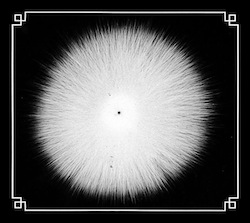Castevet : Obsian

It’s not something that’s been discussed much on message boards or blogs, but I’ll let you in on a secret that shouldn’t stay as such — Castevet’s debut album, Mounds of Ash, is one of the best black metal debuts of the last 10 years. It’s a pretty comfortable distance from traditional black metal, whatever that even means in 2013, and if you’d rather call it “progressive metal,” or “experimental metal” or “post-black metal,” then go right ahead. None of these is wrong, which is part of what makes Castevet such an interesting band. Their sound is complex and fluid, owing as much to post-rock, post-hardcore and progressive rock as it does to black metal, with various textural and atmospheric surprises to be heard between its serpentine riffs and volcanic rhythms. A Stereogum “Under the Influence” article in 2011 gave an even deeper look at the kinds of sounds the band soaked in while writing and recording the album — black metallers Kvist and Summoning, jazz pianist Cecil Taylor, free-improv guitarist Derek Bailey, darkwave group Lycia and Talk Talk’s Laughing Stock.
Three years later, with the even more complex Obsian, it seems all the more disingenuous to even call Castevet black metal. Ian Jacyszyn is still a vessel for relentlessly intense drumwork — though he rarely reverts to a standard blast beat here. And new bass player Nick McMaster has earned his share of progressive black metal cred in fellow New Yorkers Krallice. But Obsian is less concerned with black metal technique than it is with using the darkness and ferocity of black metal as a means of pursuing more adventurous musical paths.
The opening gallop of “The Tower” is the closest the band gets to basics: Andrew Hock tremolo picks his way through a melancholy torrent of chords over Jacyszyn high-speed backing and McMaster’s melodic, twisting basslines. But it doesn’t stay there for long. In its second half, “The Tower” breaks up into sections of shifting tempos and spiraling, polyrhythmic progressions. It can take a few listens to fully get a grasp on what’s happening here, though even at its most knotty and labyrinthine, it’s captivating.
As it was with Mounds of Ash, however, Castevet are at their best when blending abrasive, sinewy aggression with ominous, bleak atmosphere. The best such instance is on “The Curve,” a seven-minute epic of a track that finds the band taking harrowing segues between Hock’s mesmerizing riffs and passages of haunting subtlety, closing out with faint, ambient reverberations. The more rhythmically powerful “As Fathomed By Beggars and Victims” delivers its own curious mix of doom and breakneck time signature changes, transitioning between sprightly sprint and bass-heavy, visceral pummel. And while it’s not catchy in a conventional sense, it’s got one of the strongest melodies here, as strange and unpredictable as it is.
Obsian is driven by beastly aggression as much as it is nimble, virtuosic musicianship, but in its final two tracks, it transitions to subtler, prettier spaces. The title track and “The Seat of Severance” form a lengthy suite that moves from shoegaze-like ambience to a slow-chugging sludge metal dirge with clean-sung vocals from Extra Life’s Nick Podgurski. And in their understated, less hyperkinetic form, Castevet proves just as powerful, while presenting a whole new aspect of their sound that has yet to be fully explored. As hard as it is to peg Castevet’s place in metal’s ever expanding and intersecting network of styles, “progressive” seems to at least accurately summarize their aversion to following conventional routes. The trip is winding and unfamiliar, but with a far more awe-inspiring endpoint.
Similar Albums:
 Krallice – Diotima
Krallice – Diotima
 Tombs – Path of Totality
Tombs – Path of Totality
 Gorguts – Colored Sands
Gorguts – Colored Sands
Jeff Terich is the founder and editor of Treble. He's been writing about music for 20 years and has been published at American Songwriter, Bandcamp Daily, Reverb, Spin, Stereogum, uDiscoverMusic, VinylMePlease and some others that he's forgetting right now. He's still not tired of it.

